The Burning of Cork: December 11-12, 1920
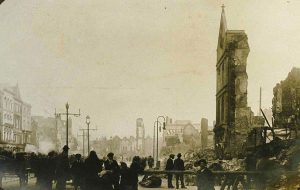
The Auxiliaries burn out the centre of Cork city in reprisal for an IRA ambush. By John Dorney
On the morning of December 12, 1920, the Sinn Fein activist Liam de Roiste walked through his native city of Cork. What he saw left him horror struck;
Last night in Cork was such a night of destruction and terror as we have not yet had. An orgy of destruction and ruin: the calm sky frosty red – red as blood with the burning city, and the pale cold stars looking down on the scene of desolation and frightfulness. The finest premises in the city are destroyed, the City Hall and the Free Library.[1]
The previous night, while Cork city was under military curfew, imposed on December 10, the supposed forces of order – the Royal Irish Constabulary (RIC) Auxiliary Division to be precise – had set fire to the centre of Cork with petrol and grenades. By the following morning, when Liam de Roiste and other Corkonians emerged to poke around the charred ruins, they found that most of the city’s main commercial thoroughfare, Patrick’s Street, had been burned to the ground.
The City Hall and the Carnegie Library were indeed, as Roiste noted, blackened piles of ash, along with 57 business premises. Another 200 buildings were damaged, some of which were also wrecked and looted. The cost of the destruction was estimated at over £2.5 million and over 2,000 people were put out of work.[2]
On the night of December 11-12, 1920 Auxiliary policemen burned much of the commercial centre of Cork city to the ground.
While in parliament at Westminster the Chief Secretary for Ireland, Hamar Greenwood, tried to argue that the Auxiliaries were not responsible, alleging the damage had been caused by ‘looters’, the letters of one Auxiliary officer to his mother tell a different story,
‘I contracted a chill on Saturday night during the burning and looting of Cork of which I took perforce a reluctant part … We did it all right, never mind how much the well intentioned Hamar Greenwood would excuse us’.[3]
How had the capital of Ireland’s southern province of Munster come to a stage where the police were, under cover of martial law, burning down the grandest buildings of the city centre?
An ugly, intimate war
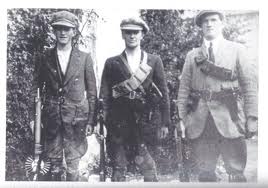
The burning of Cork was a reprisal for an IRA ambush on the same night at Dillon’s Cross, on the north side of the city. More broadly, it was part of an ugly, intimate war in the tight, steep streets of the city on river Lee. Since 1919, when the confrontation between the forces of the Crown and of the unilaterally declared Irish Republic had begun, Cork had been at the centre of the storm.
In March of 1920, in revenge for the shooting of an RIC constable, policemen had assassinated the Sinn Fein Lord Mayor of Cork, Tomas MacCurtain. His successor, Terence MacSwiney was arrested and died on hunger strike, after an agonising fast in Brixton Prison in London, in November 1920. His successor in turn, Donal O’Callaghan, only escaped arrest by stowing away on a ship to America.[4]
The RIC police were buffeted, not only by physical attacks, but also by public ostracism and a boycott, which was placed on them in January 1919. In the summer of 1920 they were reinforced by the notorious Black Tans – new, mostly British recruits to the RIC – and, more pertinently, the Auxiliary Division, in effect a dedicated counter insurgency corps of ex-officers, most of whom had served in the Great War.
The Auxiliaries were a force both hated and feared by the IRA and much of the civilian population.
The Black and Tans developed a bad reputation for ill-discipline, but the Auxiliaries, who were much better paid than either the regular police or Army in Ireland, tended to be far more aggressive towards Republicans and the population. The city of Cork was garrisoned in December 1920, as well as by regular RIC and British Army units, by K Company of Auxiliaries, who were stationed at Victoria (now Collins) military barracks.
Only two weeks before the burning of Cork, at Kilmichael, west of the city, a column from the Cork IRA’s Third Brigade had wiped out a patrol of 18 Auxiliaries (C Company), after which martial law was proclaimed throughout the County. To say the Crown forces, and the Auxiliaries in particular, were in a vengeful mood after Kilmichael would be an understatement.
According to IRA officer Sean Healy, the Auxiliaries’, ‘foul deeds of murder, rapine and arson will never be forgotten by the citizens of Cork’. He alleged that in the first week of December 1920, the Auxiliaries had burned down two local businesses in Cork city simply because their signs were written in Gaelic script.[5]
While Healy was obviously biased, a member of K Company, the same man who confirmed the Auxiliaries had been responsible for the burning of Cork wrote, ‘In all my life… I have never witnessed such orgies of murder, arson and looting as I have seen in the last 16 days with the RIC Auxiliaries.’[6] The IRA’s roll of honour lists 10 of its members ‘murdered by British forces’ in County Cork in the month prior to the burnings.[7]
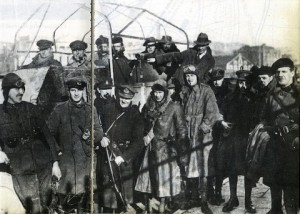
The war in the city was a terrifying mixture of clandestine IRA patrols, obtrusive checkpoints manned by the Crown forces, and the occasional terrifying collision between the two.
Michael O’Donoghue for instance, originally of Lismore, County Waterford, but recruited to the IRA while studying engineering at the city’s University, describes life as an urban guerrilla in the weeks leading up to the events of December 10, 1920.
He lived at a ‘digs’ on the north side of the city, with several other active Volunteers. At least once a week, they would collect weapons, usually the urban guerrilla’s tools of handguns and grenades, from a hidden dump and go ‘on patrol’.
Clandestine IRA squads patrolled Cork city with concealed weapons looking for targets of opportunity.
Most of the time, their patrols came to nothing. In the first week of December 1920 for example, ‘We spent hours hovering around waiting to have a crack at the military party from the prison, who occasionally slipped out for an adventurous ‘refresher’ at the local hostelry. But again we drew a blank. At 6 pm we dispersed and I dumped my erratic .38 [pistol] in the active service unit dump at UCC [University College Cork]’. [8]
On Saturday December 11, he again received orders to collect a weapon from his unit’s dump and, with ten or so young men, mostly also students at UCC, attempt to find a military or police target to attack. They found no such target and eventually dumped their guns in the cache at the University.
They were fortunate they had dumped their arms, as on their way back into town they were indeed searched by several ‘Auxies’, who likely as not, would have summarily executed them if they had caught them with weapons. Instead, after being roughly searched, they were told to ‘clear off to hell’.
Once back in their digs, news began to come in of a ‘terrible ambush’ at Dillon’s Cross.[9]
The Dillon’s Cross Ambush
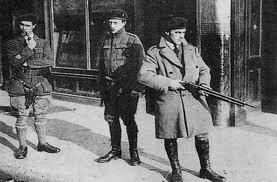
According to Sean Healy, ‘A Company’ of the Cork city IRA had noticed that the Auxiliaries at Victoria Barracks left there every evening at 8 pm by the same route through Dillon’s Cross on their way into the city centre.
Six men under an IRA battalion officer Sean O’Donoghue lay in wait for the Auxiliaries at Dillon’s Cross, armed with handguns and grenades, at a tight corner where the Auxiliaries’ lorries would have to slow down to about 5 miles an hour.
Once the lorries slowed, the guerrillas threw their bombs and opened fire. One grenade exploded right inside one of the lorries with lethal effect. According to Sean Healy, ‘wounded and screaming Auxiliaries could be seen on the roadway’.
There were twelve Auxiliary casualties at the ambush at Dillon’s Cross, one killed and eleven wounded.
One cadet, Spencer Chapman, was killed outright and eleven of his comrades were badly wounded. British troops from the nearby barracks quickly flooded the area, and the outnumbered and outgunned IRA men had to make a run for it, evading powerful searchlights and bloodhounds. They got away through the darkness into the countryside. Healy commented laconically, ‘hell was then let loose on Cork city’.[10]
Michael O’Donoghue was in his digs when he heard the news and thought, ‘from the moment we heard of the bloody ambush of the Auxies that night we had a peculiar sense of impending tragedy, a foreboding that something terrible was going to happen.’ Revenge, they knew, was certain, the only question was what form it would take.
The Burning of Cork
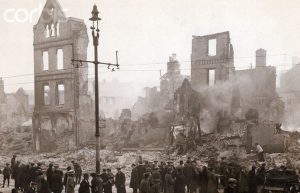 The houses around the ambush site at Dillon’s Cross were the first to be destroyed by the vengeful Auxiliaries, consisting of about 50 men of K Company, who then headed towards the commercial heart of the city.
The houses around the ambush site at Dillon’s Cross were the first to be destroyed by the vengeful Auxiliaries, consisting of about 50 men of K Company, who then headed towards the commercial heart of the city.
The regular RIC and British Army appear not to have participated in the burnings, but do not appear to have tried to stop the Auxiliaries either.
Auxiliary officer Charles Schulze, wrote to his mother: ‘I just escaped the ambush [at Dillon’s Cross]… but later arrived as a reinforcement. We took sweet revenge,” … Houses in the vicinity were set alight and from there various parties set out on their mission of destruction.”[11]
Michael O’Donoghue slipped into a hotel on Grand Parade and at about 9:30 watched as heavily armed Auxiliaries broke down the shutters of Sean Jennings’ Furniture Store on Patrick Street and throw in ‘bomb after bomb’. ‘With each explosion comes the sound of breaking glass and falling and smashing wood’. [12]
According to one Auxiliary ‘we took sweet revenge’ for the ambush by burning the centre of Cork.
Across the street they smashed the windows of a jewellery shop and looted the contents, taking armfuls of jewels each, in O’Donoghue’s recollection. At this point O’Donoghue heard shots and saw fire leap into the sky from the other end of Patrick’s Street. The Auxiliaries had set many of the big businesses there – Grant’s Department store, Cash’s and the Munster Arcade – alight.
Roughly 1000 yards away, and across the River Lee from Patrick’s Street, O’Donoghue could hear a huge explosion as bombs exploded at Cork’s City Hall, which was soon in flames too. Shortly afterwards, the neighbouring Carnegie library and its collection of books also went up.
The Cork Fire Brigade, when called out, first made sure the Auxiliaries had not put the city’s water pumping station out of commission, then cautiously made their way into the city centre. They found the southern half of Patrick’s Street ablaze and the fire was moving southwards, consuming some of the smaller streets behind. It took an all-night effort on their part to prevent all of the centre from being consumed by flames.
The fire-fighters found many of the Auxiliaries to be drunk and aggressive. Some tore up the fire brigade’s hoses with their bayonets. The firemen trying to guard the City Hall had shots fired and grenades thrown at them. Four fire fighters were taken to hospital with bullet wounds by the end of the night.[13]
By special request of the Cork Fire Brigade, a party of Dublin fire fighters arrived by special train at 1:30 am to assist them. By morning, most of the fires were under control.
It was perhaps fortunate that, due to the military curfew, there were no civilians around to take the brunt of the Auxiliaries’ anger. Elsewhere in the city though, on Dublin Hill, the Auxiliaries broke into the home of two young IRA men, the Delaney brothers, and shot them dead.[14]
By the following morning, much of Cork’s commercial centre was a smouldering ruin. Michael O’Donoghue went to Catholic Mass in the city centre the following day and found, ‘the fires were now for the most part burnt out though many buildings still smouldered and crumbling walls fell now and then on the smoking debris to send mushrooms of ashes smoke and sparks into the air.’[15]
The Irish Times reported that, ‘the scenes presented today were lamentable. From Merchant’s Street, which is some little distance from Patrick’s Bridge, on to Cook Street, on the left side of Patrick’s Street, there is a devastated area which covers no less than five acres. It was all valuable property, embracing some of the most flourishing establishments in the province of Munster’.[16]
Explaining the reprisal
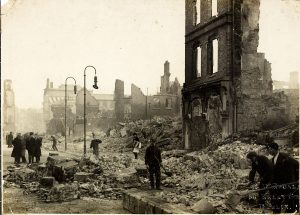 That Crown forces would seek revenge after guerrilla attacks killed one of their number is perhaps unsurprising. What is surprising however is the utterly indiscriminate nature of the Auxiliaries’ assault on Cork’s main shopping street.
That Crown forces would seek revenge after guerrilla attacks killed one of their number is perhaps unsurprising. What is surprising however is the utterly indiscriminate nature of the Auxiliaries’ assault on Cork’s main shopping street.
Big business owners, after all, were generally not supporters of radical nationalism, still less of the IRA. Surely such random vandalism would only drive the civilian population into the arms of the guerrillas? Why then, were the Auxiliaries allowed to get away with such behaviour? K Company was moved to Dunmanway and the company eventually disbanded in March 1921, but none of its members appear to have been punished.[17]
One reason for the official lenience on the Auxiliaries was that for months the British authorities had turned a blind eye to such ‘unofficial reprisals’. Towns from Tuam in the west, to Balbriggan in County Dublin and Trim in Meath in the east, to Thurles, Ennistymon, Mallow and Tralee in Munster, had all been targeted for burning in the previous six months.[18]
British prime minister Lloyd George thought that reprisals had been ‘effective at checking crime in Ireland… since time immemorial’.
One senior British politician, Lord Riddell, noted after meeting the Prime Minister Lloyd George in October 1920 that, ‘I came away with the conclusion that this was an organised movement [of reprisals] to which the Government are more or less assenting parties.’ Lloyd George, apparently would have preferred if troops and police had confined themselves to shooting ‘Sinn Feiners’ rather than burning property, but felt that reprisals ‘ had, from time immemorial, been resorted to in difficult times in Ireland… where they had been effective in checking crime’.
Indeed, in January of the following year, destruction of the property of alleged Sinn Fein or IRA sympathisers became official British government and military policy in Ireland.[19]
While some of the destruction in Cork can probably be put down to drunken malice on the part of the Auxiliaries, there appears to have been logic behind their actions too. If too great a price was paid by the Irish civilian population for IRA actions, public opinion might force the guerrillas to call off their campaign. In Youghal, the Resident Magistrate declared that if ‘Sinn Feiners and the majority of moderate men’ did not denounce ‘murders’ by the IRA, then ‘they cannot escape responsibility for them’.[20]
While this appears to be an utterly self-defeating strategy on the part of the British, it was perhaps not completely so. Many civilians did indeed disapprove of IRA actions, blamed them in part for the reprisals and wanted both to stop. One such voice was Dr Daniel Coholan, Catholic Bishop of Cork, who, that Sunday, the day after the burning of Cork, issued a decree of excommunication on IRA members who took part in attacks on Crown forces. He blamed the burning of Cork on the ‘murderous ambush at Dillon’s Cross’. [21]
While this was a morale blow to the IRA in Cork, most of whom were practicing Catholics, it did nothing to halt the violence there. The city and county remained the epicentre of violence in War of Independence until the Truce of July 11, 1921.
Ultimately though, the burning of Cork city centre, did hurt the reputation of the British state in Ireland more than they terrorised the population into compliance.
Taken together with another incident four days later in which an Auxiliary in West Cork shot dead a priest and a disabled boy, it appeared to show the Sinn Fein’s portrayal of British rule as ‘tyranny’ was correct. The British public too recoiled from what was being done in their name, not in a far off colony but in the neighbouring island, still in theory part of the United Kingdom.
As historian Michael Hopkinson put it, ‘what mattered most was the perception of British responsibility and guilt… the most significant events in the War of Independence should be judged by the effect they had on public opinion and the headlines they generated rather than on the scale of military conflict’. [22]
Of all such images emerging from Ireland, of bodies by the roadside and smoking, charred houses, none was perhaps as visually striking as the smouldering ruins in the centre of Cork city in December 1920.
References
[1] Thomas McCarthy, Rising from the Ashes, The burning of Cork’s Carnegie Library and the Rebuilding of its collections, Cork City Libraries, 2010, P.6-7
[2] David Leeson, The Burning of Cork in The Atlas of the of the Irish Revolution p.382
[3] Cited in Michael Hopkinson, The Irish War of Independence, p.83
[4] Thomas Cathy, Rising from the Ashes, p.10-12
[5] Sean Healy BMH WS 1479
[6] Hopkinson, War of Independence, p.83
[7] The Last Post, pp.107-111, and this does not count civilians, nor does it count four Cork Volunteers listed at ‘killed in action’ and another three who were killed by the premature detonation of their own bomb.
[8] Michael O’Donoghue BMH WS 1,741
[9] O’Donoghue BMH
[10] Healy, BMH, for the Auxiliaries’ casualties, see WH Kautt, Ambushes and Armour, The Irish Rebellion 1919-1921, p156. According to one source, the target of the attack was a British Army intelligence officer, Captain J Kelly.
[11] The Auxiliaries Website, The Burning of Cork, http://www.theauxiliaries.com/INCIDENTS/cork-burning/cork-burning.html
[12] O’Donoghue BMH
[13] Pat Poland, History Ireland, The Burning of Cork http://www.historyireland.com/volume-23/the-burning-of-cork-december-1920-the-fire-service-response/
[14] The Last Post, p 111, Jeremiah Delaney died on the spot, his brother Con lingered for two weeks before succumbing to his wounds.
[15] O’Donoghue BMH
[16] Irish Times, December 14, 1920
[17] http://www.theauxiliaries.com/INCIDENTS/cork-burning/cork-burning.html Though one, Edgell, was reduced in rank from company commander to section leader. When K company was disbanded most were simply moved to other companies.
[18] Hopkinson, War of Independence p.80
[19] For Lloyd George’s view of ‘unofficial reprisals’ see Hopkinson War of Independence p. 82 and for offical Reprisals, ibid. p.93
[20] Irish Times, December 13, 1920
[21] https://stairnaheireann.net/2015/12/12/1920-the-roman-catholic-bishop-of-cork-daniel-colahan-issued-a-decree-saying-that-anyone-within-the-diocese-of-cork-who-organises-or-takes-part-in-ambushes-or-murder-or-attempted/
[22] Hopkinson, p.83-84. The priest killed at Dunmanway was Canon Magner, the young man was Timothy Crowley.